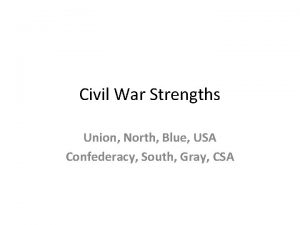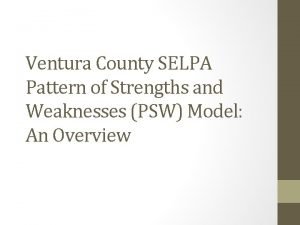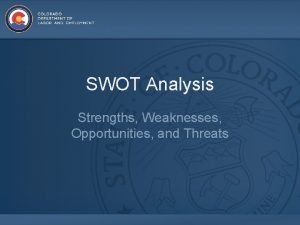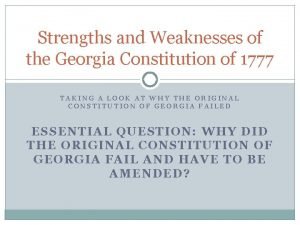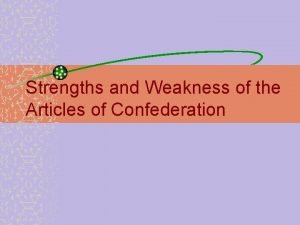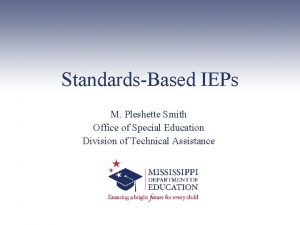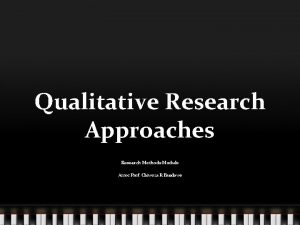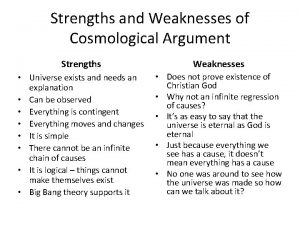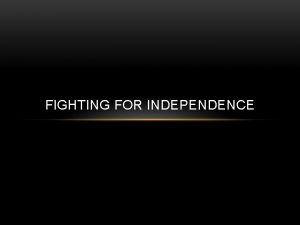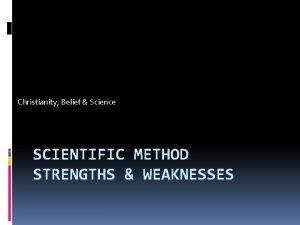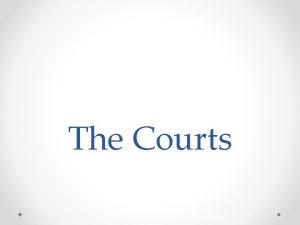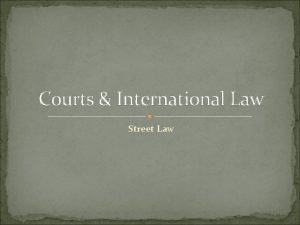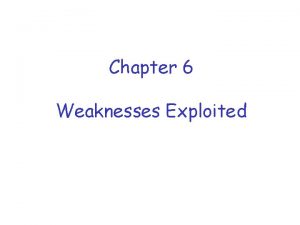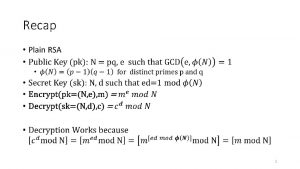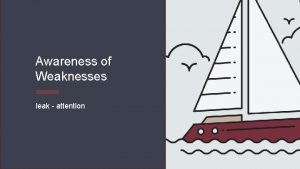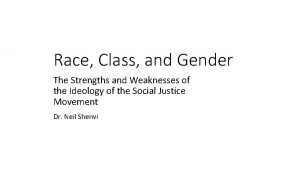SOURCES OF LAW THE COURTS STRENGTHS AND WEAKNESSES
























- Slides: 24

SOURCES OF LAW: THE COURTS STRENGTHS AND WEAKNESSES OF THE COURTS AS A SOURCE OF LAW. THE INTERACTION BETWEEN THE COURTS AND PARLIAMENT.

SOME STRENGTHS AND WEAKNESSES OF THE COURTS IN MAKING LAW Strengths Weaknesses The courts can change the law quickly if a relevant case is brought before them. Courts can only consider legal issues if a dispute is brought before them for resolution. The courts cannot take the initiative and create a new legal principle in the absence of an actual case coming before them. Courts need only consider issues of justice and rights when hearing cases. They are not subject to political considerations. The courts do not always reflect current community thinking and values. Judges in the courts have some capacity to depart from established precedents especially if the case before them is somewhat different from a precedent case. The doctrine of precedent can lock the courts into out-of-date legal concepts. Courts can fill in gaps in the law as they make Case law through the courts is ex post facto, that is, decisions on particular cases that come before them. legal rules are created after the fact.

STRENGTHS AND WEAKNESSES For further strengths and weaknesses, as well as additional detail, go to Chapter 5 of your textbook; there are two very helpful tables.

THE INTERACTION BETWEEN THE COURTS AND PARLIAMENT Courts and parliament interact in the law-making process. They need to work together so that the law is flexible and can be applied to any situation that might arise.

THE INTERACTION BETWEEN THE COURTS AND PARLIAMENT Common law (law made through courts) arose from the local customs of England existed before any statutes had been passed. Statutes have confirmed, added to and altered common law. The courts are responsible for settling disputes. Many disputes are settled by the courts by interpreting the words in an act of parliament. As a secondary role, on occasions, the courts also make laws.

THE INTERACTION BETWEEN THE COURTS AND PARLIAMENT Parliament is the supreme law-making body. This is also referred to as sovereignty of parliament. Parliament’s main role is to make laws. As a supreme law-making body, parliament can make laws that either confirm or reject laws made by courts. However, the Commonwealth Parliament cannot override High Court interpretations of the Commonwealth Constitution.


THE INTERACTION BETWEEN THE COURTS AND PARLIAMENT The relationship between courts and parliament can be summarised as: • parliaments pass acts to establish courts • courts apply and interpret the law made by parliament • parliament can change or confirm law made by courts • court decisions can influence changes in the law by parliament.

PARLIAMENTS PASS ACTS TO ESTABLISH COURTS For a court to exist there must be an act of parliament that establishes the courts, and sets out its jurisdiction. For example the Tasmanian Parliament passed the Magistrates Court Act 1987.

COURTS APPLY AND INTERPRET THE LAW Courts need to apply acts to cases for legislation to be effective. This sometimes involves interpretation; decisions about the meanings in statutes for precedents that become part of the law to be followed in the future. Example: Franklin Dam case The High Court (important role) – division of power For interpretation to take place an individual or group must take matter to court (expensive but parliaments have passed acts setting up legal assistance bodies – Legal Aid – In Tasmania: Legal Aid Commission Act 1990)

PARLIAMENT CAN CHANGE OR CONFIRM LAW MADE BY THE COURTS Courts depend on parliament to make the bulk of the law. Parliament depends on courts to apply the law made by parliament and to establish new law on situations that have arisen for the first time. Parliament can confirm a precedent made in court by passing an act that reinforces the principles established by the court. Parliament can also change the law to override a decision made through the courts (other than High Court interpretations of the Constitution). Why? Courts sometimes don’t reflect intention through their interpretations and/or the interpretations don’t reflect current meaning. Courts also sometimes interpret the common law (made up of precedents set in the past) in a conservative way that no longer reflects current values in the community.

COURT DECISIONS CAN INFLUENCE CHANGES IN THE LAW BY PARLIAMENT Parliament influenced by: Comments made by judges/magistrates during court cases. When a judge is bound by a precedent that results in injustice. A progressive decision made by the courts could reveal need for change in law to reflect current values.

COURT DECISIONS CAN INFLUENCE CHANGES IN THE LAW BY PARLIAMENT Key reasons that parliament might be influenced to change law: - Courts may be too conservative (further investigation required) - Courts’ decisions highlight problems - Creativity by courts (e. g. The Mabo decision by the High Court) - Lenient sentences can lead to change in the law

CASE STUDY: THE MABO CASE (1992) Title of the case (1 mark) Briefly outline the facts of the case (2 marks) Discuss the strengths and weaknesses of law-making by courts in relation to this case. (4 marks) What are the effects of statutory interpretation? (4 marks) Explain how the case illustrates the relationship between courts and parliament in law-making. (4 marks) -> SEE PAGE 261 -262

SHORT ANSWER QUESTIONS Monday 22 nd August – choose TWO (one from each section) Parliament-made law (Statute law) a) Briefly explain how parliament makes law. Does parliament keep the executive accountable? b) What is statute law? Explain the strengths and weaknesses of legislation as a source of law. Court-made law (Common law and Statutory interpretation) a) What is the doctrine of precedent? Evaluate the strengths and weaknesses of this doctrine. b) What role do judges have in law-making (common law and statutory interpretation). Assess some of the strengths and weaknesses of court-made law. c) What is statutory interpretation? Assess interaction between the courts and parliament when judges interpret legislation.

HOW TO STRUCTURE YOUR SHORT ANSWER Think of your short answer as a mini-essay; it needs an introduction, body paragraphs and a conclusion. A short answer question usually has TWO parts to it. Make sure you answer both parts. Examiners expect 2/3 description and 1/3 analysis.

Avoid too much detail about your points in your introduction. Save this for the body paragraphs! Introduction: A broad statement which introduces the topic. (e. g. The Doctrine of Precedent is fundamental to court-made law…) Another sentence which further explains the main ideas (e. g. It is based on the concept of ‘stare decisis. . ’) A list of the key points to be made. (e. g. Discussed in this answer will be……, ……. and …. . ) An evaluative sentence. (While the Doctrine of Precedent can be restrictive, it is crucial to…)

Body paragraphs: Topic sentence: The Doctrine of Precedent is based the same process as that used by king’s judges of the past, and refers to the concept of stare decisis. Explain: Example if relevant: Explain: Summary sentence:

Conclusion: List points (like you did in introduction) Broad statement Evaluative sentence

A) BRIEFLY EXPLAIN HOW PARLIAMENT MAKES LAW. DOES PARLIAMENT KEEP THE EXECUTIVE ACCOUNTABLE? Some key ideas: Parliament is supreme law-making body There a number of steps for a bill to pass parliament and become law (remember the parliament role play) The executive (the government – Malcolm Turnbull and Coalition at federal level) have considerable power when it comes to making law because they have the majority in the lower house (House of Reps). This means that bills introduced by government are more easily passed. Government tends to control the agenda in Parliament keeps the executive accountable through a concept known as responsible government; the Opposition (providing alternative/question time etc. ), the Second Reading debate, The Senate (House of Review), Parliamentary committees etc. No Bill of Rights Two-party system. Voting on party lines. Some useful sources: Textbook – Chapter on Law-making through parliament Class blog How to pass a bill (class handout) http: //australianpolitics. com/democracy/key-terms/parliament-and-government http: //australianpolitics. com/democracy/key-terms/responsible-government http: //www. parliamentarystrengthening. org/committeesmodule/pdf/UNIT%206. pdf http: //www. aph. gov. au/About_Parliament/Parliamentary_Departments/Parliamentary_Library/pubs/rp/rp 0001/01 RP 14

B) WHAT IS STATUTE LAW? EXPLAIN THE STRENGTHS AND WEAKNESSES OF LEGISLATION AS A SOURCE OF LAW. Some key ideas: Actually relatively new source of law (when compared with common law). It developed to deal with a rapidly growing and changing society. Now the dominant form of law. Parliament-made law – influences (individuals/lobby groups/petitions/media/law reform bodies) Initiating/drafting/passing of bills Strengths and weaknesses (see Textbook also could link with same-sex marriage or examples) Some useful sources: Textbook – Law-making through parliament chapter Your previous assignment on this topic https: //www. youtube. com/watch? v=cjs. TJV 1 i 620 (good for examples) https: //www. youtube. com/watch? v=vuyi. LZFr. CAU

A) WHAT IS THE DOCTRINE OF PRECEDENT? EVALUATE THE STRENGTHS AND WEAKNESSES OF THIS DOCTRINE. Some key points: Precedent is based on the concept of stare decisis (to stand by what has been decided) Relates to the court hierarchy (you will need to explain how) It is vital for predictability, fairness, consistency and equality before the law. It can be described as inflexible Judges can work around this inflexibility through distinguishing/reversing/overruling and disapproving (State Govt. V. Trigwell case – see Textbook) Examples Some useful sources: http: //www. hcourt. gov. au/assets/publications/speeches/former-justices/kirbyj_17 jul 06. pdf Textbook – Chapter 5 https: //www. youtube. com/watch? v=ysf. JJT 6 o 4 j. M (What is the Doctrine of Precedent? ) http: //tallangattalegalstudies. weebly. com/strengths-and-weakness-of-precedent. html

B) WHAT ROLE DO JUDGES HAVE IN LAW-MAKING (COMMON LAW AND STATUTORY INTERPRETATION). ASSESS SOME OF THE STRENGTHS AND WEAKNESSES OF COURT-MADE LAW. Some key points: Probably a good idea to briefly explain the difference between the role of parliamentarians and the role of the judge in making law. Independence of the judiciary (judges appointed rather than elected). Judges have other duties apart from purely law-making therefore not the supreme law-making body like the parliament. Also need to explain difference between common law and statutory interpretation. Strengths and weaknesses. Examples: (Common law: Donoghue v. Stevenson 1932 Statutory interpretation: Deing v. Tarola 1993 and/or Tasmanian Dams case (1983) Some useful sources: Textbook chapter 5 file: ///C: /Users/ella. kearney/Downloads/978052117106 w 03. pdf http: //vceseminars. org. au/engagedownloads/Workbooks/Legal%20 Studies%20 Workbook%20 Extract. pdf https: //www. youtube. com/watch? v=h. DKVn. EKloo 0

C) WHAT IS STATUTORY INTERPRETATION? ASSESS INTERACTION BETWEEN THE COURTS AND PARLIAMENT WHEN JUDGES INTERPRET LEGISLATION. Some key points: The courts’ role in interpreting the general meaning and specific wording of acts of parliament (statutes) Reasons for statutory interpretation (mention some problems that arise with parliament-made law and the subsequent need for statutory interpretation) Interaction between the courts and parliament: necessary. Happens in following ways: • parliaments pass acts to establish courts • courts apply and interpret the law made by parliament • parliament can change or confirm law made by courts • court decisions can influence changes in the law by parliament – Former PM Paul Keating did this with Mabo…to protect this decision made by High Cout. Mabo case (1992) – despite this ground-breaking case, native title has actually become harder… Current examples? Some useful sources: This Power. Point Textbook – Chapter 5 https: //www. youtube. com/watch? v=UOe. QNdmutg. Y https: //www. aph. gov. au/binaries/senate/pubs/pop 42/coper. pdf https: //www. youtube. com/watch? v=s. A 29 KHDw 0 Wc (Mabo case explained)
 Swot analysis johnson and johnson
Swot analysis johnson and johnson Marks and spencer competitors analysis
Marks and spencer competitors analysis British strengths
British strengths Strengths and weaknesses of the union and confederacy
Strengths and weaknesses of the union and confederacy North and south strengths and weaknesses chart
North and south strengths and weaknesses chart Glanzer and cunitz strengths and weaknesses
Glanzer and cunitz strengths and weaknesses Myers briggs strengths and weaknesses
Myers briggs strengths and weaknesses Taba theory
Taba theory Ventura county selpa
Ventura county selpa Strengths and weaknesses of token economy
Strengths and weaknesses of token economy Weaknesses and strengths of the articles of confederation
Weaknesses and strengths of the articles of confederation Teacher input examples
Teacher input examples Cos swot analysis
Cos swot analysis 3 strengths and weaknesses
3 strengths and weaknesses Capsim swot analysis
Capsim swot analysis Strengths and weaknesses examples
Strengths and weaknesses examples Hades strengths
Hades strengths Georgia constitution of 1777
Georgia constitution of 1777 Articles of confederation strengths and weaknesses
Articles of confederation strengths and weaknesses Plaafp strengths and weaknesses examples
Plaafp strengths and weaknesses examples What is schema
What is schema Strenghts of quantitative research
Strenghts of quantitative research Strength and weaknesses of ethnography
Strength and weaknesses of ethnography Weaknesses of the psychodynamic approach
Weaknesses of the psychodynamic approach Mohost manual
Mohost manual



